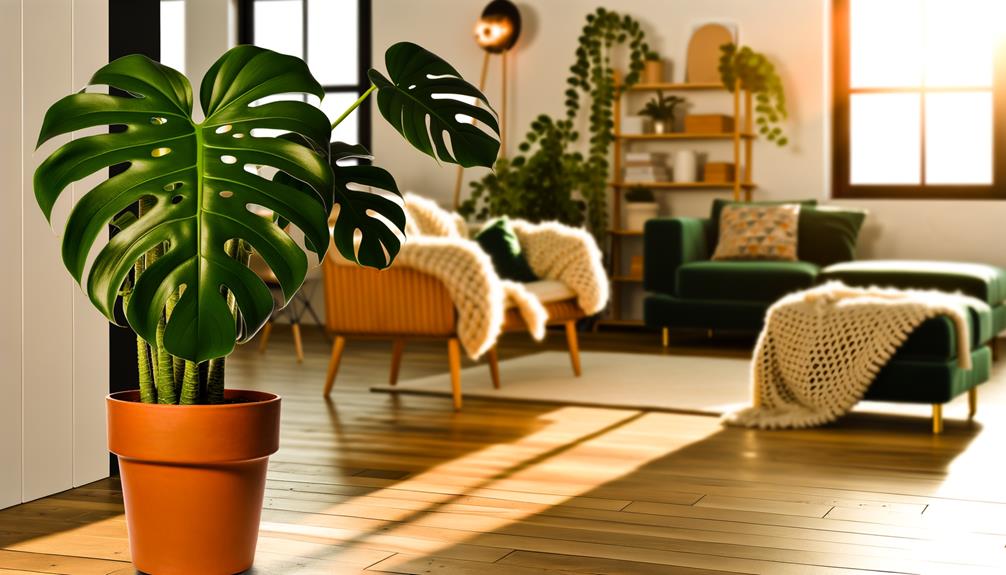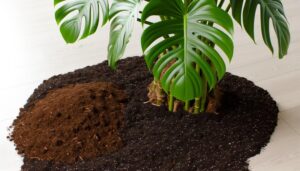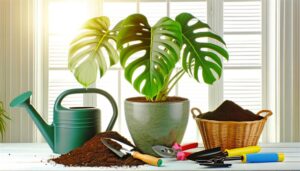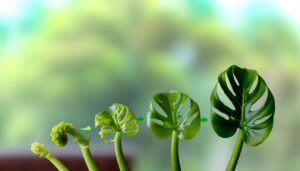Monstera Pinnatipartita Dubai
Monstera pinnatipartita flourishes in Dubai if you replicate its native tropical habitat. Assure bright, indirect light and maintain temperatures between 18-27°C (64-81°F).
Use well-draining soil with peat, perlite, and orchid bark. Water when the top 2-3 inches of soil are dry, and keep humidity levels around 60-80%.
The deeply lobed, pinnatifid leaves with glossy upper surfaces and matte undersides need monthly cleaning. Prune every 2-3 months and propagate with stem cuttings.
Regularly inspect for pests to prevent infestations. Mastering these details will enhance your plant's health and growth.
There's intriguing information waiting just ahead.

Key Takeaways
- Monstera Pinnatipartita thrives in bright, indirect light suitable for Dubai's indoor environments.
- Ensure temperatures between 18-27°C and humidity levels around 60-80% for optimal growth.
- Use well-draining soil mixes and water when the top 2-3 inches are dry to prevent root rot.
- Regular pruning every 2-3 months and monthly leaf cleaning are essential for plant health.
- Weekly pest inspections and balanced fertilization every 6-8 weeks are recommended for maintenance.
Origin and History
Monstera pinnatipartita, native to the tropical rainforests of Central and South America, particularly thrives in the regions of Ecuador, Peru, and Brazil. You'll find this species in humid, shaded environments where it clings to trees using its aerial roots. Its habitat provides the consistent moisture and warmth essential for its growth.
Historically, indigenous communities utilized Monstera pinnatipartita for medicinal purposes. The plant's climbing nature, classified as a hemiepiphyte, means it starts life on the forest floor, eventually ascending to the canopy. Understanding its origins helps you appreciate its adaptability and resilience.
When cultivating Monstera pinnatipartita, mimicking its natural conditions, such as indirect light and high humidity, is key to encouraging healthy growth and development in non-native environments.
Identifying Features
You'll recognize the Monstera pinnatipartita by its deeply lobed, pinnatifid leaves that exhibit fenestrations as the plant matures. Initially, the leaves are entire and elliptical, but as they age, they develop intricate lobes and splits, known as fenestrations.
The mature leaf structure is pinnatifid, meaning deeply divided yet not completely separated, giving it a characteristic lace-like appearance. Stems of Monstera pinnatipartita are thick and rigid, supporting aerial roots that help the plant climb.
The adaxial (upper) leaf surface is glossy, while the abaxial (lower) surface is matte, providing a distinct texture contrast. Leaf venation is prominent, with a central midrib and lateral veins that extend towards the leaf margins, enhancing its visual appeal and aiding in identification.
Ideal Growing Conditions
To guarantee best growth for Monstera pinnatipartita, you'll need to provide bright, indirect light and maintain temperatures between 18-27°C (64-81°F).
Consistent watering is essential, but avoid waterlogging; the substrate should be well-draining.
Additionally, maintaining a humidity level of around 60-80% will mimic its native tropical habitat.
Light and Temperature Needs
For best growth, make certain Monstera pinnatipartita thrives in bright, indirect light and maintains an ambient temperature between 18°C and 27°C.
This plant, originating from tropical rainforests, requires a light intensity that resembles dappled sunlight. Direct sunlight can scorch its delicate, pinnate leaves, causing discoloration and stress. Position it near a north or east-facing window for ideal light exposure.
Regarding temperature, avoid placing it in areas with drafts or sudden temperature fluctuations. Consistent warmth supports its metabolic processes, aiding in healthy foliage development. If temperatures drop below 15°C, growth will slow, and the plant may become vulnerable to damage.
Maintaining these conditions will guarantee your Monstera pinnatipartita flourishes robustly indoors.
Watering and Humidity Tips
Consistently maintain moderate soil moisture for Monstera pinnatipartita, ensuring the top inch of soil dries out between waterings. Use tepid, dechlorinated water to avoid root shock. Monitor soil moisture using a hygrometer. Monstera pinnatipartita thrives in 60% to 80% humidity. Employ a humidifier or pebble tray to meet these requirements. Avoid overwatering, which can lead to root rot (rhizopus spp.).
| Condition | Ideal Range |
|---|---|
| Soil Moisture | Moderately moist |
| Humidity | 60% to 80% |
| Watering Frequency | When the top inch is dry |
Ensure air circulation to prevent fungal infections. Mist the leaves to replicate natural humidity. Avoid drafts as they can stress the plant. Proper watering and humidity contribute to vibrant, fenestrated foliage.
Watering Requirements
Proper hydration is necessary for Monstera pinnatipartita, requiring a well-balanced watering schedule to maintain its lush foliage and vigorous growth. You should water Monstera pinnatipartita when the top 2-3 inches of soil feel dry to the touch.
Overwatering can lead to root rot (Pythium spp.), while underwatering causes leaf browning and stunted growth. Make sure you use tepid, non-chlorinated water to avoid shocking the plant's root system. Regularly monitor the plant's wilting and leaf curl as indicators of moisture imbalance.
It's essential to provide consistent moisture, especially during the growing season (spring and summer). During dormancy (fall and winter), reduce watering frequency but don't let the substrate dry out completely. This balanced approach ensures peak health and resilience.
Soil and Fertilization
To guarantee Monstera pinnatipartita thrives, you'll need a well-draining soil mix, combining peat, perlite, and orchid bark.
Utilize nutrient-rich fertilizers, such as balanced N-P-K formulations, to support its vigorous growth.
Regular feeding during the growing season will promote healthy foliage and robust root development.
Optimal Soil Composition
For Monstera Pinnatipartita to thrive, make sure the soil has good drainage with a composition rich in organic matter, such as peat moss and perlite. This ensures optimal aeration and moisture retention without waterlogging.
The ideal soil mix should consist of:
- Peat Moss: Enhances moisture retention and provides an acidic pH, which Monstera Pinnatipartita prefers.
- Perlite: Increases drainage and aeration, preventing root rot.
- Bark Chips: Adds coarse texture, improving root oxygenation and simulating natural habitat.
- Coco Coir: Retains moisture while allowing excellent drainage, and is more sustainable than peat.
Nutrient-Rich Fertilizers
Feeding Monstera Pinnatipartita with a balanced, slow-release fertilizer rich in nitrogen, phosphorus, and potassium promotes robust growth and vibrant foliage. Choose a fertilizer with an N-P-K ratio around 20-20-20 for best results.
Nitrogen (N) supports lush, green leaves; phosphorus (P) encourages strong root development and flowering; potassium (K) enhances overall plant health and disease resistance. Apply the fertilizer every 6-8 weeks during the growing season. Optimize even distribution around the root zone and water thoroughly afterward.
Avoid over-fertilizing as it can cause nutrient burn and damage the plant's delicate roots. Regularly monitor for signs of nutrient deficiency, like yellowing leaves or stunted growth, to adjust feeding schedules accordingly.
Light Needs
Monstera pinnatipartita thrives in bright, indirect light, mimicking its natural understory habitat in tropical rainforests.
To optimize your plant's growth, adhere to these guidelines:
- Light Intensity: Aim for 1,000 to 2,000 foot-candles, which is ideal for peak photosynthesis.
- Avoid Direct Sunlight: Direct sun can scorch the leaves, causing chlorosis or necrosis.
- Supplemental Lighting: If natural light is insufficient, consider using LED grow lights with a color temperature between 5,000K and 6,500K.
- Light Duration: Maintain a consistent light cycle of 12 to 14 hours per day, emulating the photoperiod of its native environment.
Pruning and Maintenance
In addition to ideal lighting, routine pruning and maintenance are key to ensuring Monstera pinnatipartita's robust health and aesthetic appeal. Pruning involves removing yellowed or damaged leaves to promote new growth and prevent disease. Always use sterilized pruning shears to minimize the risk of infection. Regular maintenance includes wiping the leaves with a damp cloth to remove dust, which enhances photosynthesis. Inspect for pests like spider mites or scale insects.
Here's a quick guide:
| Task | Frequency |
|---|---|
| Pruning | Every 2-3 months |
| Leaf cleaning | Monthly |
| Pest inspection | Weekly |
Propagation Methods
Propagating Monstera pinnatipartita can be effectively achieved through stem cuttings, ensuring you select a healthy node with at least one aerial root.
To get started, follow these steps:
- Cutting Preparation: Use sterilized shears to make a clean cut below the node, ensuring the cutting is 4-6 inches long.
- Rooting Medium: Place the cutting in water or a well-draining soil mix rich in organic matter.
- Environment: Maintain high humidity and place the cutting in indirect light to encourage root development.
- Monitoring: Check regularly for root growth, which usually occurs within 2-4 weeks.
Conclusion
In cultivating Monstera pinnatipartita, you've explored a fascinating world. With its distinctive fenestrated leaves, it's a plant that stands out.
Remember, 60% of its thriving depends on maintaining ideal humidity levels. Proper watering, well-draining soil, and bright, indirect light are essential.
Pruning encourages lush growth, while propagation via stem cuttings guarantees continuity. Embrace these practices, and you'll keep this botanical marvel flourishing in your home garden.






